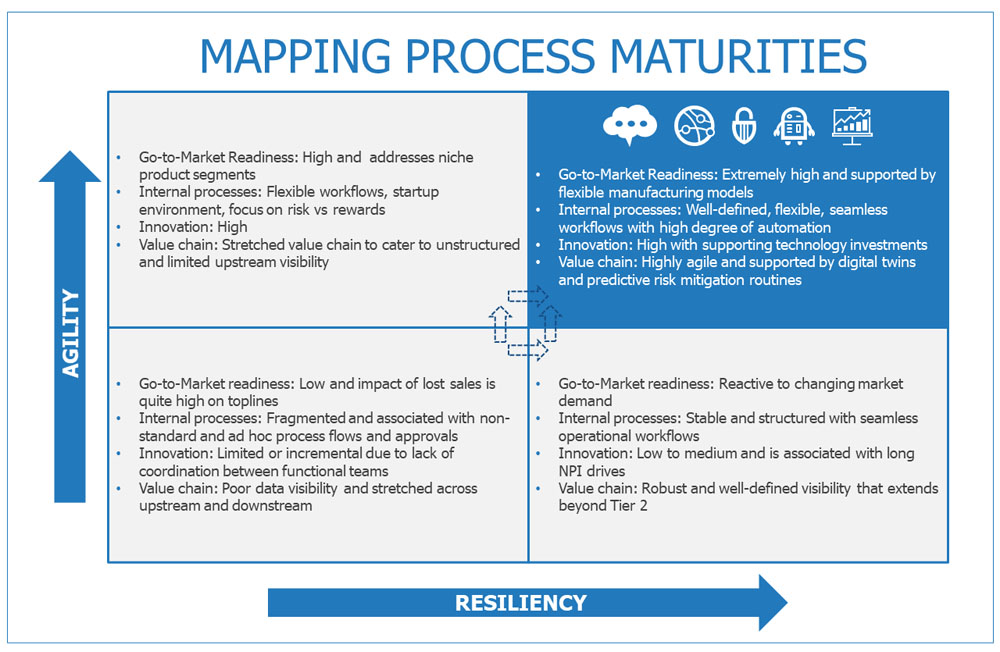Changing Focus of Digitalization

The manufacturing sector in India has been going through some massive transformations with the key focus on data-driven process designs to help address the productivity, efficiency, and quality gaps. Here’s knowing more about it.
Though the conversations around digital transformations (DX) have been going on for a while, it was in the last 18 months that the investments hit an inflection point. According to IDC's Asia/Pacific Manufacturing Insights Survey 2021, a majority of the Indian manufacturers highlighted the need for new revenue streams along with product innovations as an immediate priority to tackle the volatile market conditions. Additionally, new challenges in the form of remote access and monitoring need to be added to the operational complexity. Though a cliché, the end objective was clear - stay agile and build in/enable operational resiliency.
The common perception has been to invest in technologies that can help digitalize processes but what organizations do not account for are the 'soft costs' that are associated with fixing the existing gaps. The most important aspect of the solutioning is the creation of a baseline model that accurately identifies and estimates the perceived benefits.
The lead visual is an indicative and generic plot of how organizations view their operational readiness. The intention is to reach the far-right corner, which would be possible through a set of process reengineering drives and relevant technology implementation investments that allow improved operational visibility and enterprise performance.
Fostering digital resilience
According to a recent survey conducted by IDC Asia/Pacific Manufacturing Insights, ‘Improving the resiliency of business and operating models to reduce uncertainty and operational risk’ is one of the top five priorities for Indian manufacturers in the next 2 to 3 years. The finding also highlights the need for technology applications and data streams that allow organizations to have increased visibility of possible impediments or bottlenecks. Several organizations invest in ‘what-if’ scenario simulations coupled with contingency plans for unscheduled outages, but the lack of real-time data feed introduces lag in decision making, which increases the reaction time and subsequently impacts the resiliency frameworks. Apart from historical trends, there is a need for executable insights that subsume unstructured information feeds to overlay contextual data for addressing real-life operational challenges.
For instance, Deepak Fertilisers and Petrochemicals Corporation Ltd (DFPCL), an India-based chemicals and fertilizer manufacturers with a turnover of over US$1 billion, has launched a massive digitalization drive at four of its manufacturing facilities. One of the significant challenges was the availability of asset performance/utilization data, which was fragmented, disjointed, and present in multiple databases. Also, the organization still relied on traditional excel-based solutions that limited their respective predictive analytics roadmaps.
DFPCL’s transformation journey was quite structured. It started with gap analysis, IT/OT integration roadmaps, followed by a detailed ecosystem review to identify a viable partner who can drive and support its long-term digitalization plans. The key technologies considered and implemented were real-time analysis, AI-based machine health monitoring, and integrated S&OP (sales and operations planning). The remote monitoring technology solutions will aid the company in keeping its manufacturing assets operational even during workforce availability challenges. After implementing Supply Chain Planning, DFPCL was able to create ‘what-if’ scenarios and increase its forecast accuracies considerably. Improved upstream and downstream visibility aided in increased supply chain agility, resulting in accurate planning and forecasting metrics. These initiatives, in the long run, will provide sustainable benefits by enabling top-line and bottom-line contributions while supporting the DFPCL transformation journey.
And this is one of the many examples of how manufacturing organizations in India are pivoting on data-dependent process drives rather than the other way around. Though not every DX drive will yield similar kind of returns, organizations do agree that there are substantial benefits associated with data-centric modules.
Organizations that are uninitiated need to change their digitalization-related queries from ‘why’ to ‘when’ and start taking tangible steps towards an approach that suits their future vision, bearing in mind that an end-to-end enterprise-wide DX drive would yield much more benefits than the sum of its parts.
Internal and external buy-in The DX journey for each organization is unique and needs to be curated to address its respective internal challenges. Though not comprehensive, the following set of recommendations aid in reducing the gap between ideation and execution:
- Sell the Idea Internally - Often, the core intentions of a digitalization drive get masked by the cost reduction or organizational re-jigs resulting in resistance within. Organizations need to invest in efforts to sell the idea within to highlight the intangible benefits that feed into long-term growth aspirations rather than equating it to automation-enabled operational productivity.
- Allocate Budgets and Periodically Review the Investments - Budgets need to be allocated by considering the strategic vision of the organization. Look to invest in processes that can cut down the operational risks and improve product quality which would have a strong bearing on how the overall business shapes up in the near to medium term. DX investments need to be reviewed periodically for ensured sustenance. Also, when the DX drive is devised, specific, measurable, attainable, relevant, and timely (SMART) goals need to be created and tracked.
- Invest in Re-Skilling Initiatives - To mitigate the effect of external factors and competition, organizations tend to invest in technology applications requiring the need for outsourced services, which would significantly increase the cost of operations. One of the biggest challenges that most organizations have been facing in the recent past is the misalignment between technology vision versus people investment.
- Create Industry Consortiums - Despite the existing competition, organizations should look to form industry forums that could aid in establishing best operational practices across the various manufacturing processes. For instance, industry cloud solutions could drastically reduce the procurement and sourcing timelines and would aid in bringing renewed profits across the value chain. Similarly, smart manufacturing and logistics-specific forums could also lead to the development of custom solutions that address function and region-specific challenges.

Sampath Kumar Venkataswamy
Senior Research Manager
Manufacturing Insights
IDC Asia/Pacific
Source: IDC



 Facebook
Facebook.png) Twitter
Twitter Linkedin
Linkedin Subscribe
Subscribe